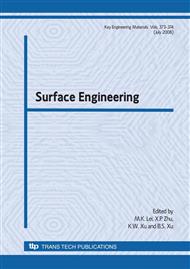p.93
p.100
p.104
p.108
p.113
p.117
p.122
p.126
p.130
Structure of Alumina Layer on the Damage Resistance of Multilayered CVD Coating under Repeated Impact Loading
Abstract:
Repeated impact test is an appropriate way to evaluate coating properties of metal cutting tools since the cyclic impact loading applied in the test simulates the interrupted cutting process. For hard CVD coatings with multi-layered structure, the alumina is usually of the lowest toughness and adhesion, and relatively easy to fail in the metal cutting. In the present paper, multilayered coatings consisting medium temperature TiCN, Al2O3 and TiN were deposited by chemical vapor deposition (CVD) on the tungsten carbide/cobalt substrate and evaluated using scratch adhesion test and repeated impacted test. The phase structure of alumina layers are α or )κ as usually applied in cutting tools, and the grain size for the α phase one is varied from one micron to four microns. The scratch and indentation test results show that the alumina layer of κ phase is easy to remove under the quasi-static loading, implying brittleness and low adhesion. The repeated impact test results reveal lower impact resistance for the κ phase alumina, and only adhesive failure can be found, which differs to that of the α phase one. The coarse grained α-Al2O3 layer shows similar adhesion compared to the fine grained α- Al2O3 in scratch test. The failure mode of the coating with coarse grained α-Al2O3 layer in the repeated impact test is primarily impact wear. No cohesive failure can be found at all load levels, and this leads to higher impact life than that of the fine grain one. It was shown that the relatively low adhesion of bottom TiCN layer may not affect the impact resistance.
Info:
Periodical:
Pages:
113-116
Citation:
Online since:
March 2008
Authors:
Keywords:
Price:
Сopyright:
© 2008 Trans Tech Publications Ltd. All Rights Reserved
Share:
Citation:


